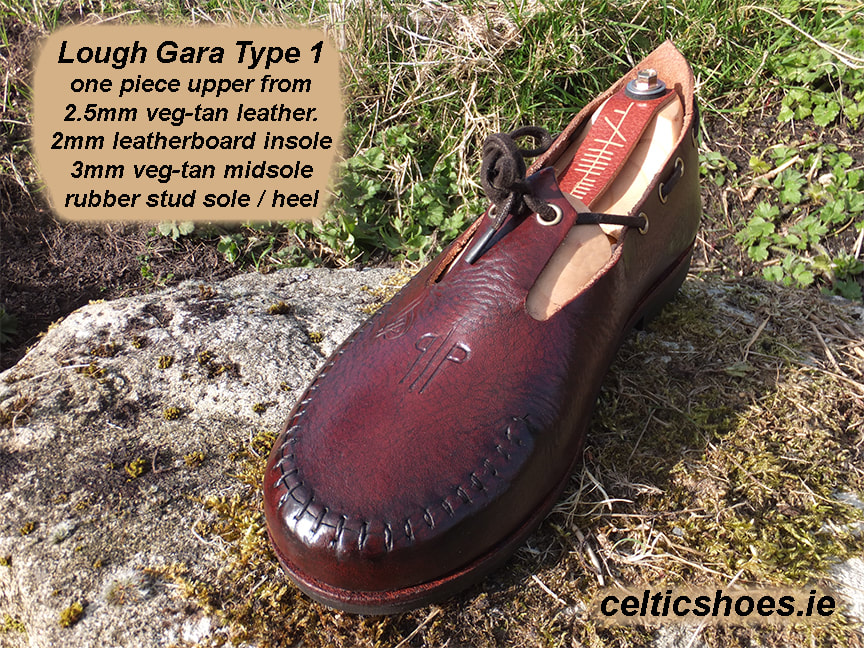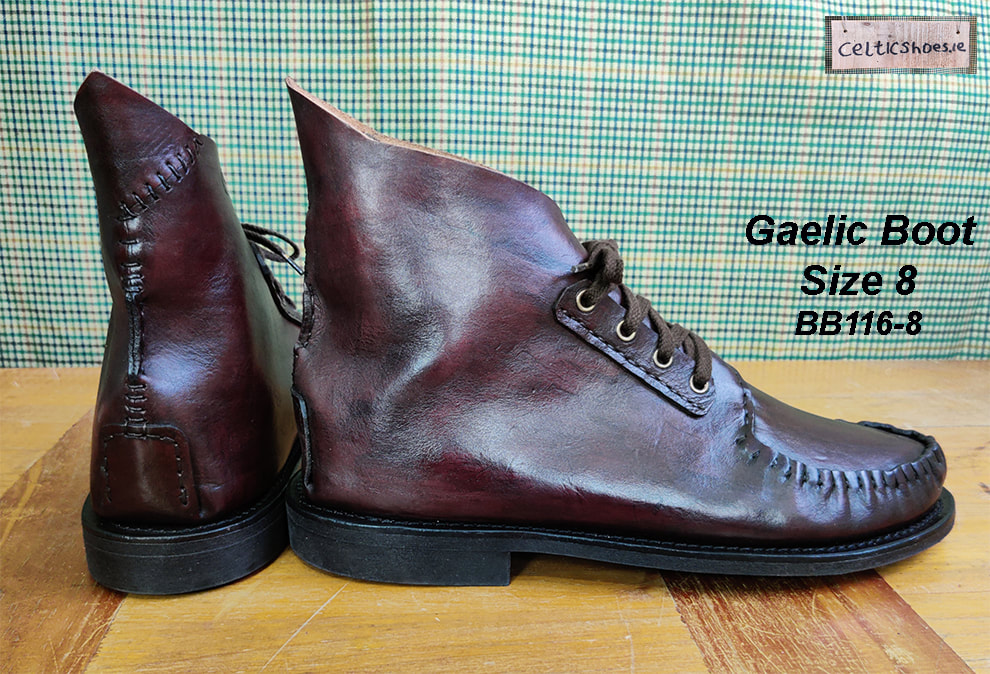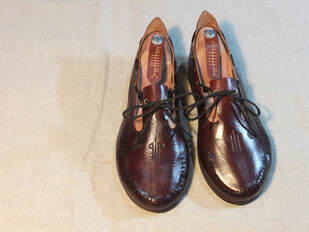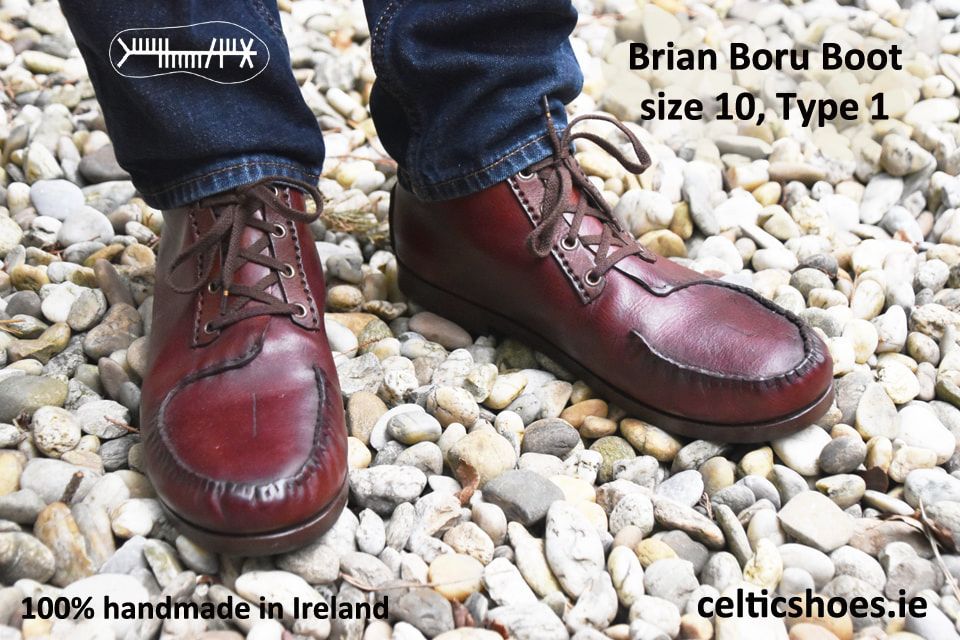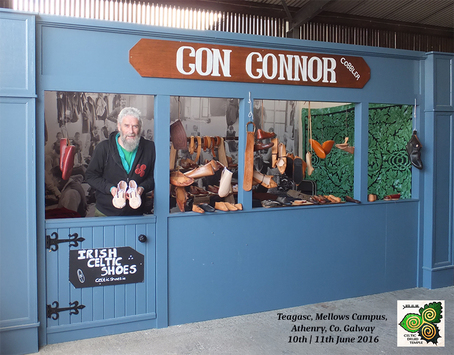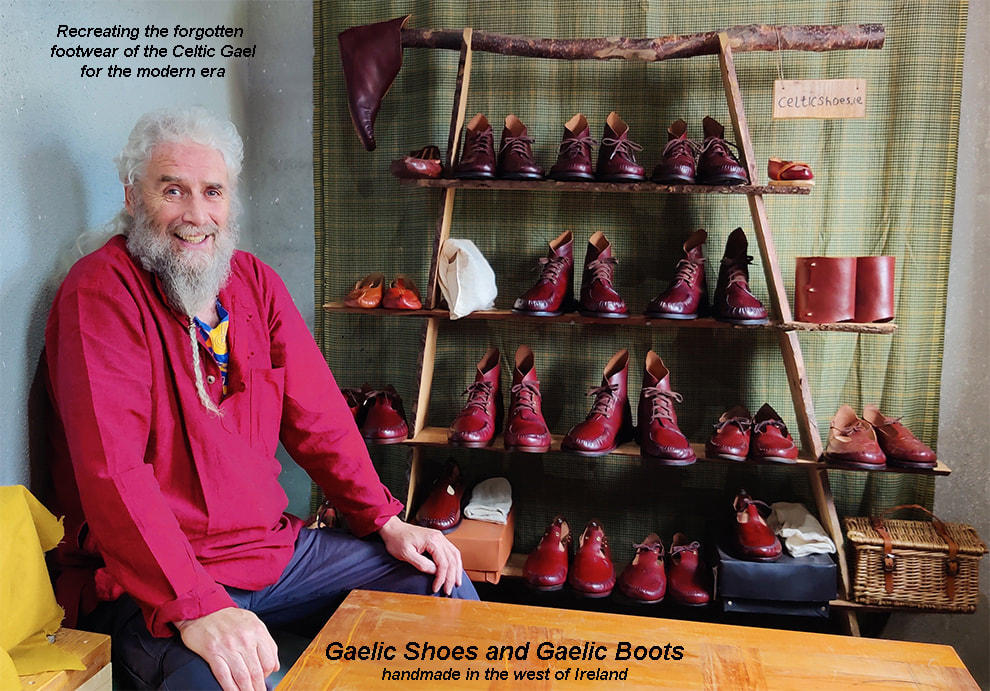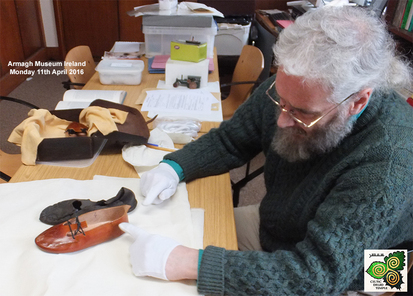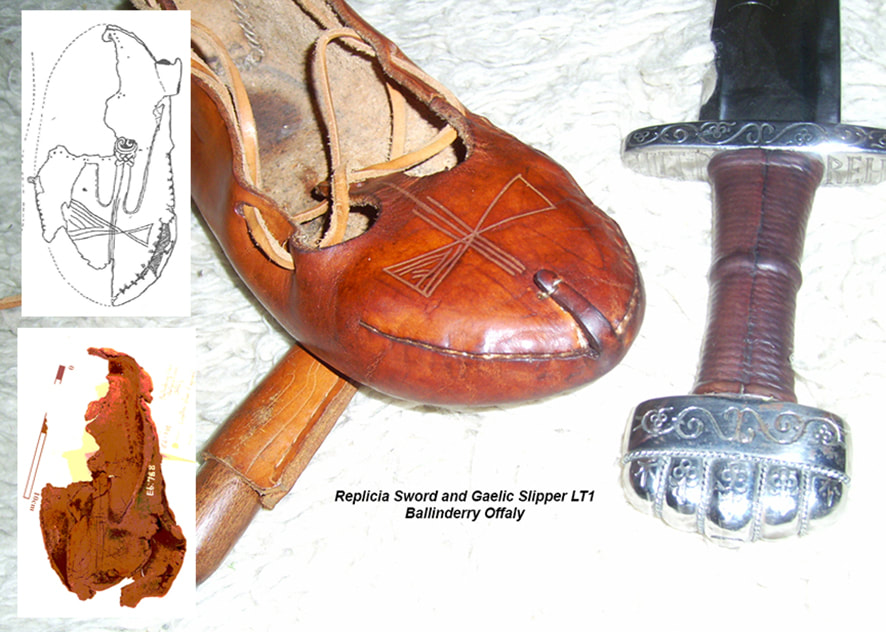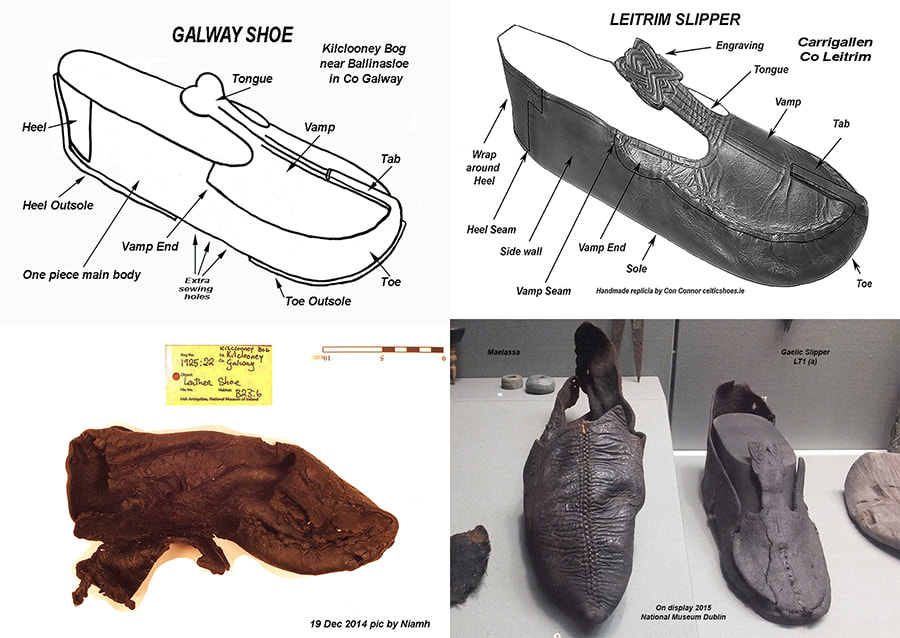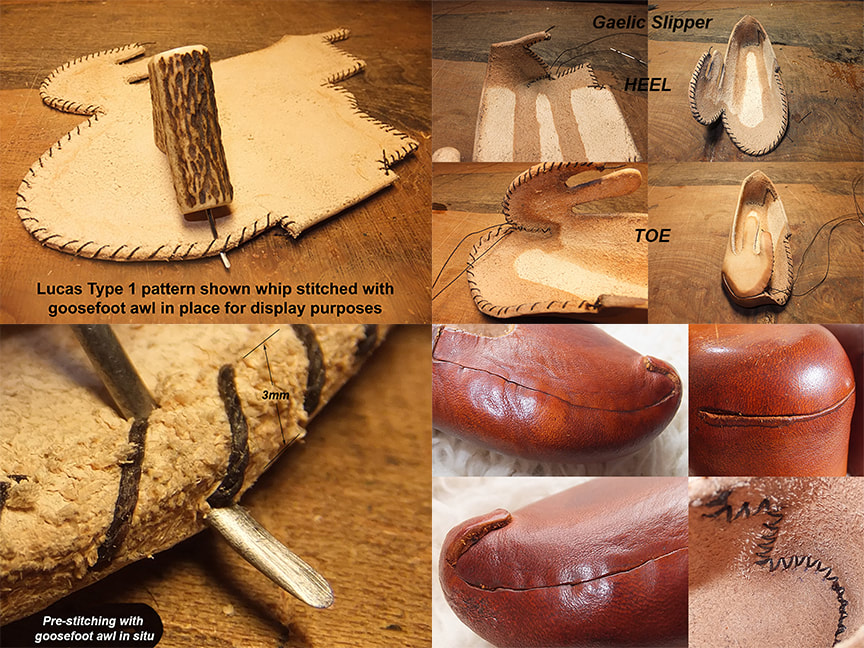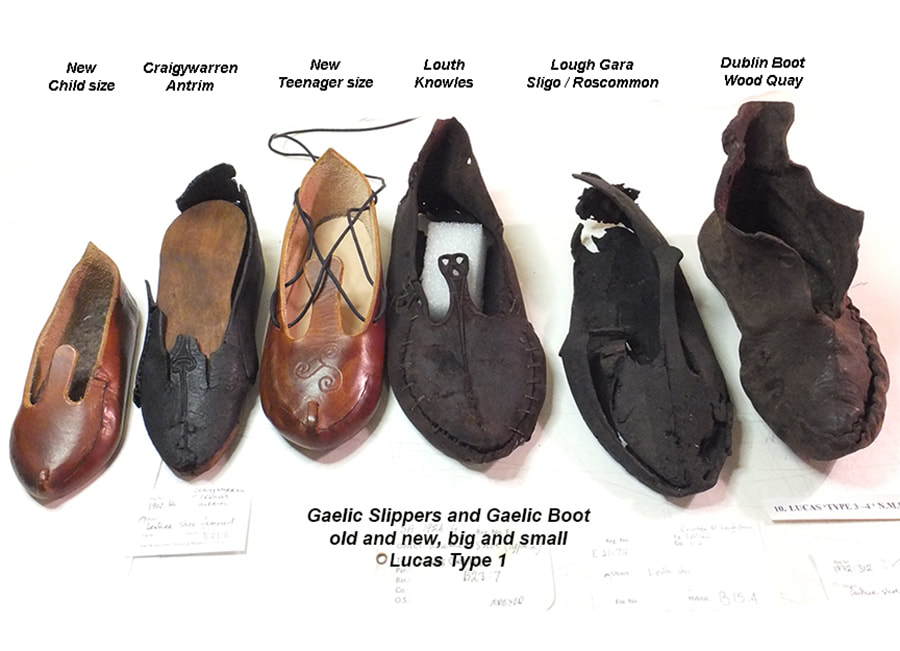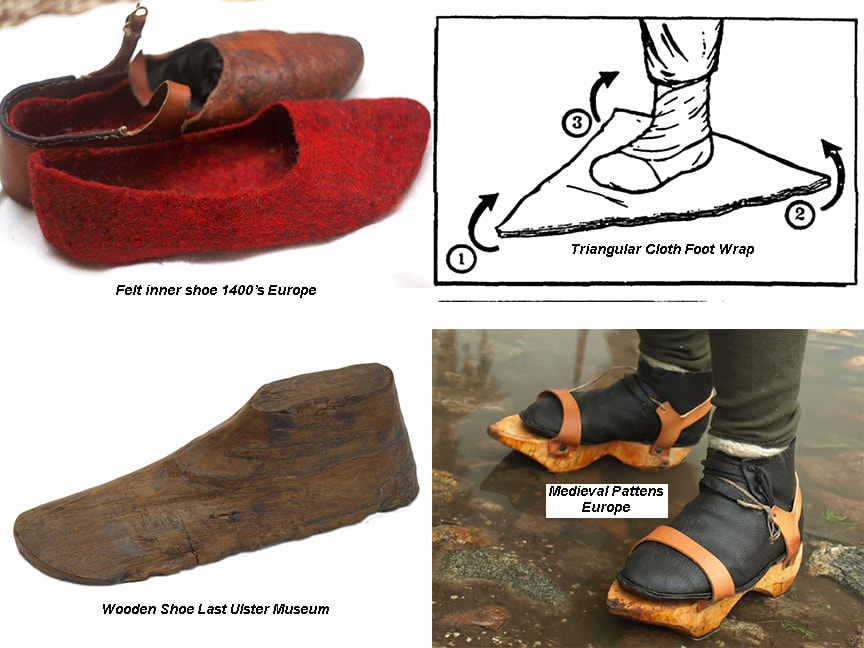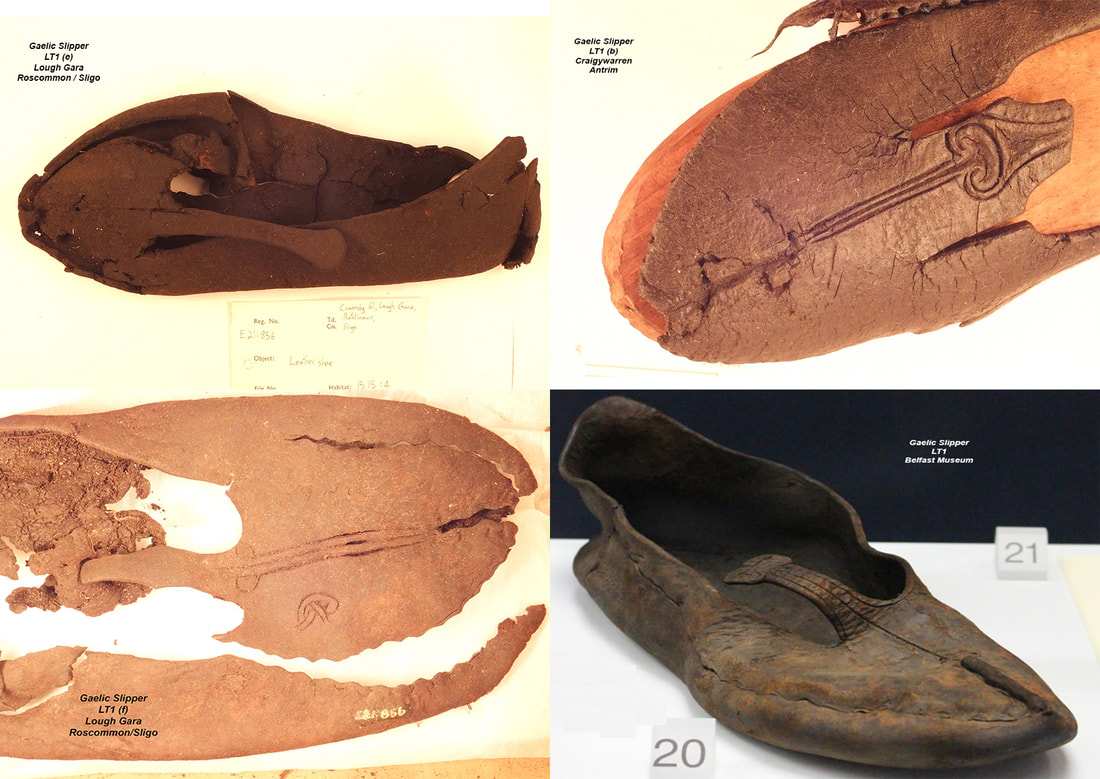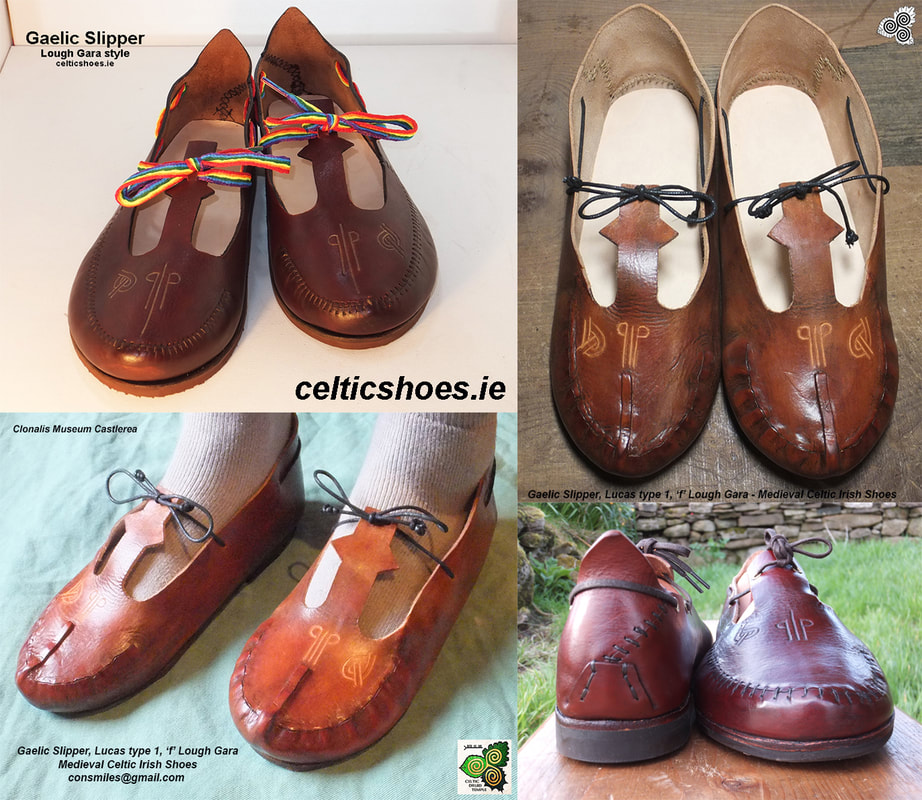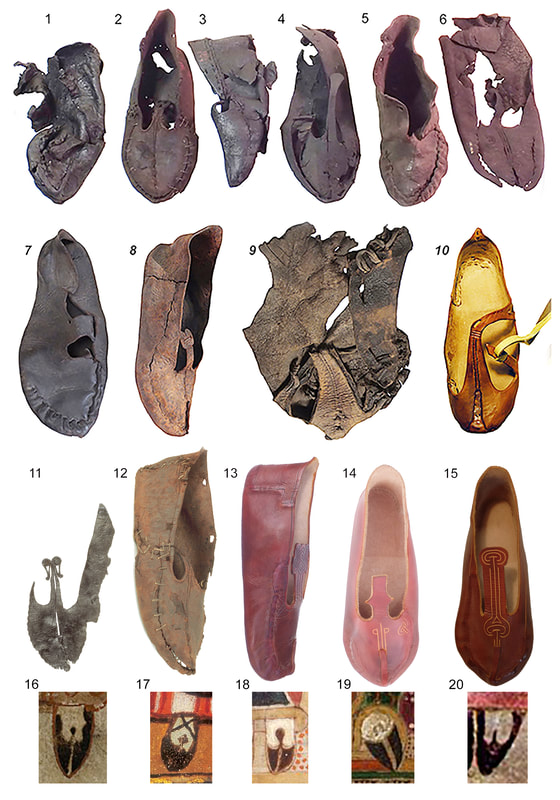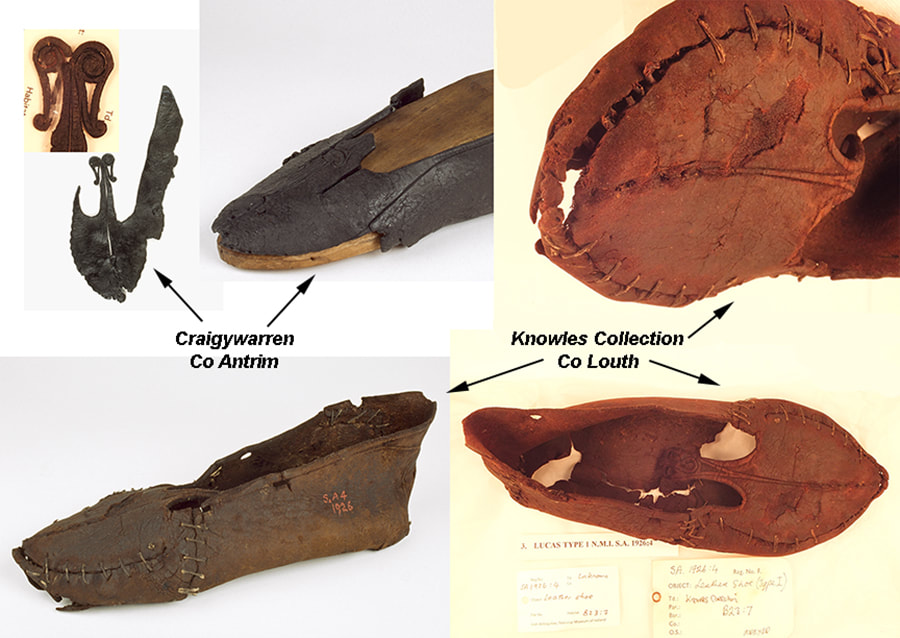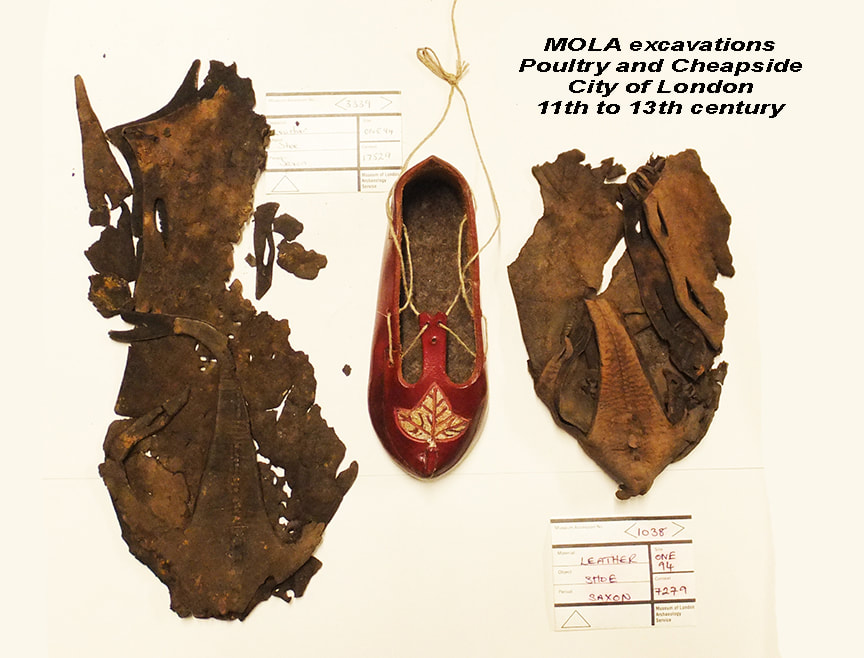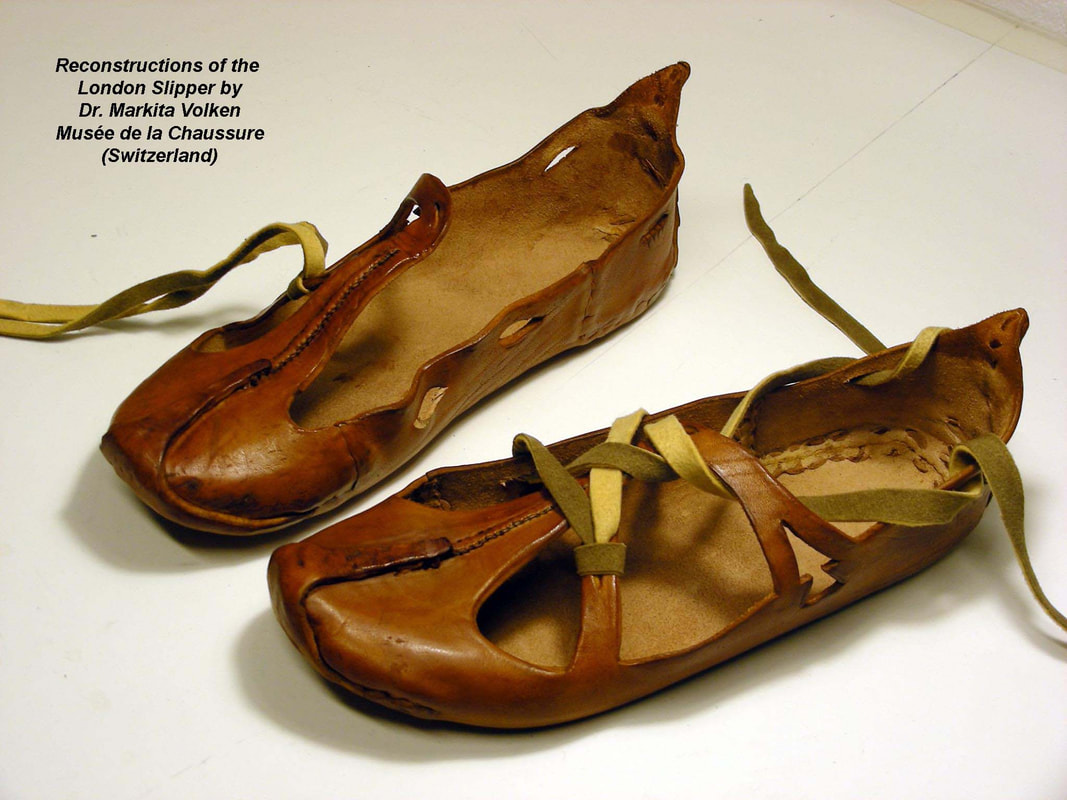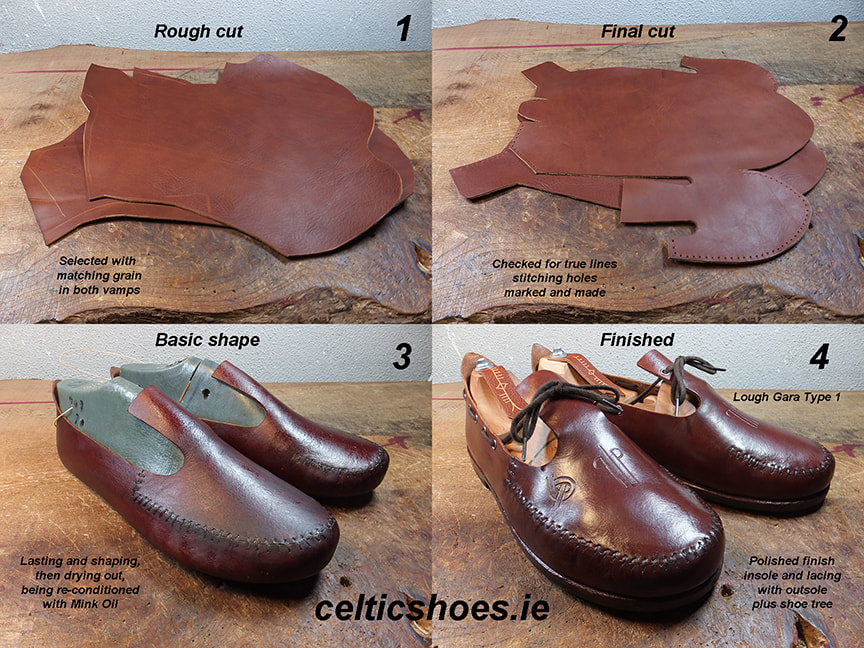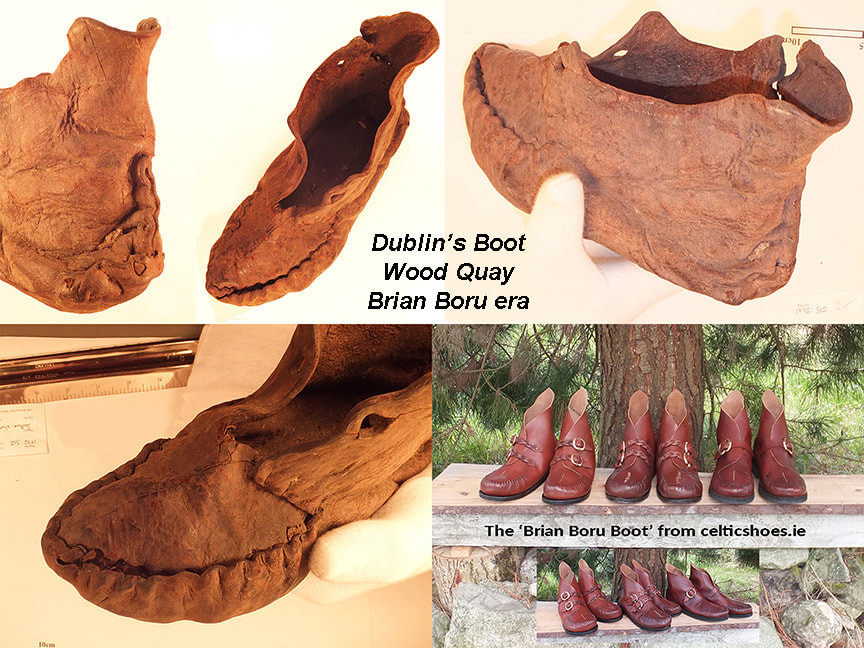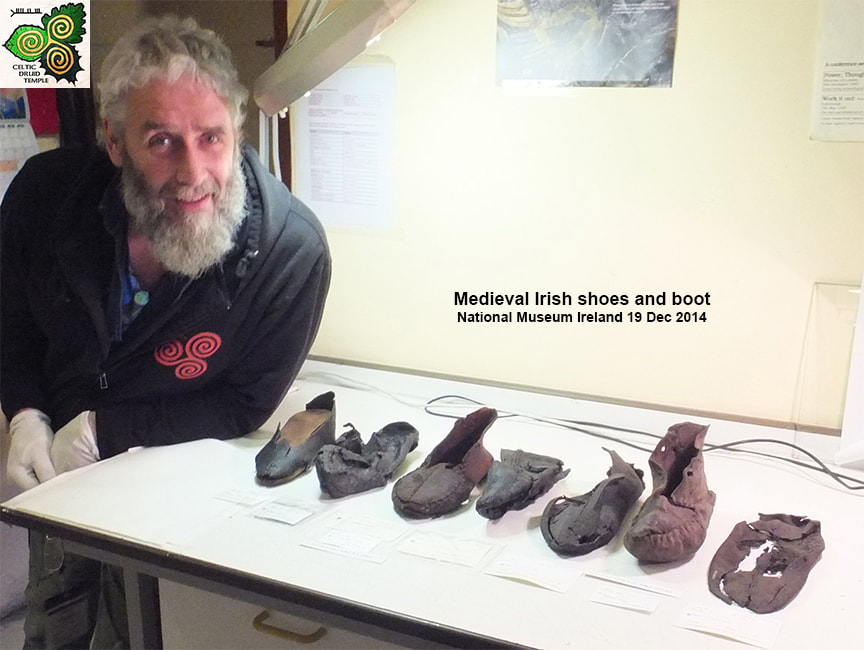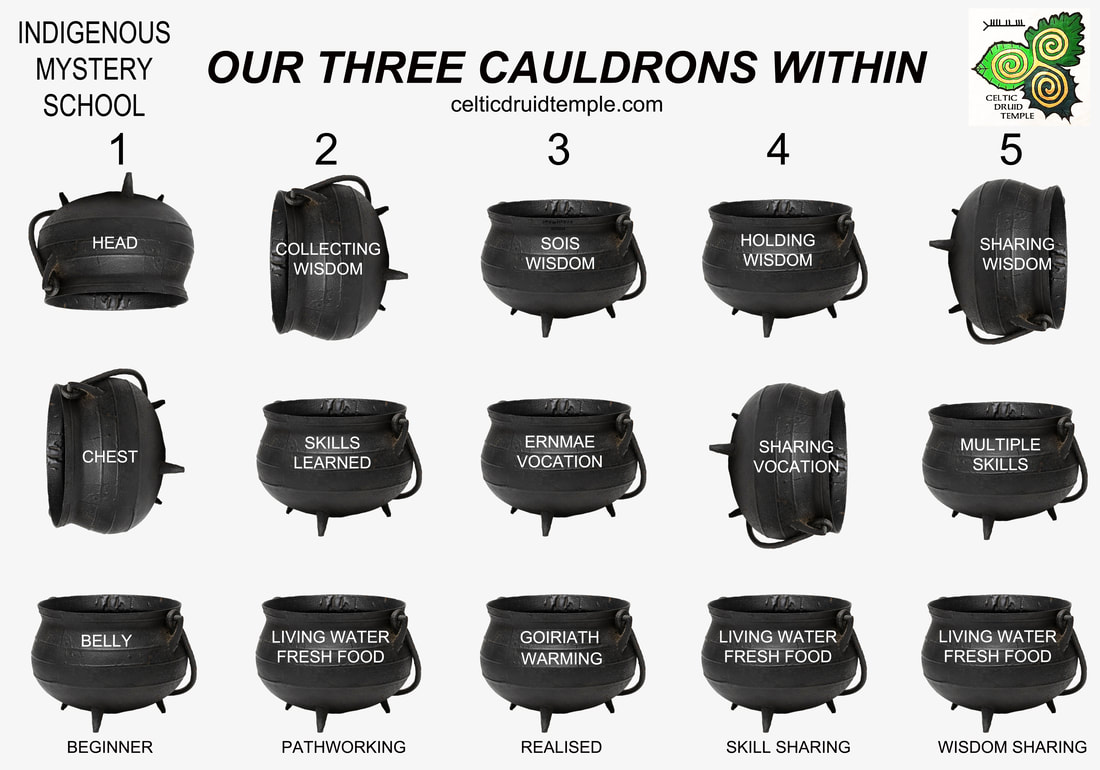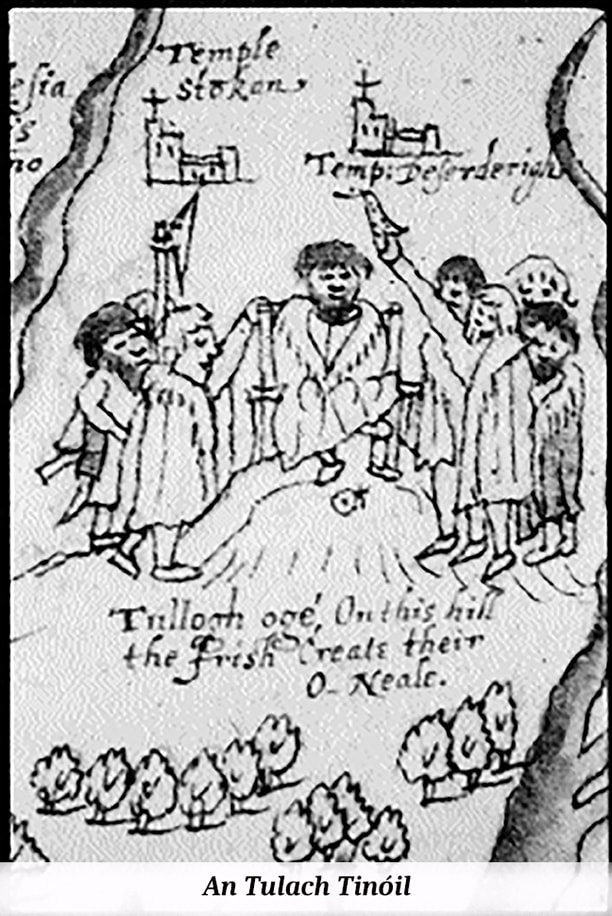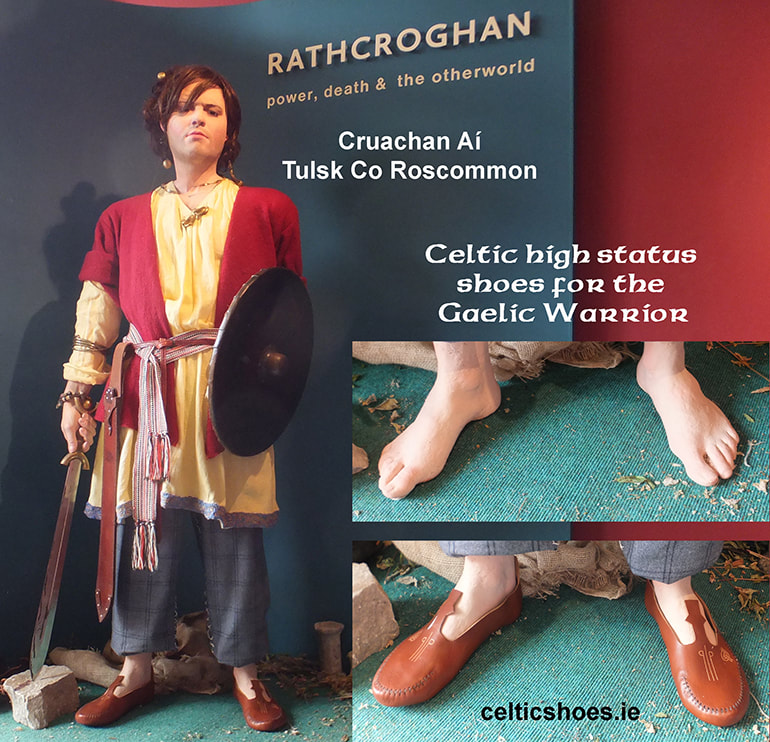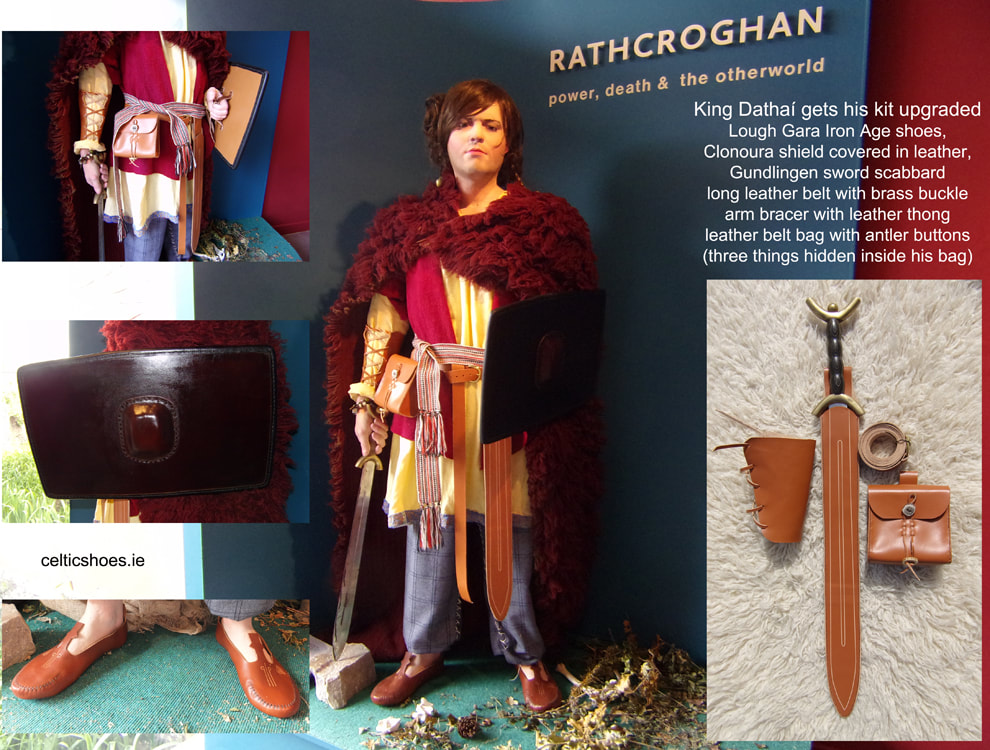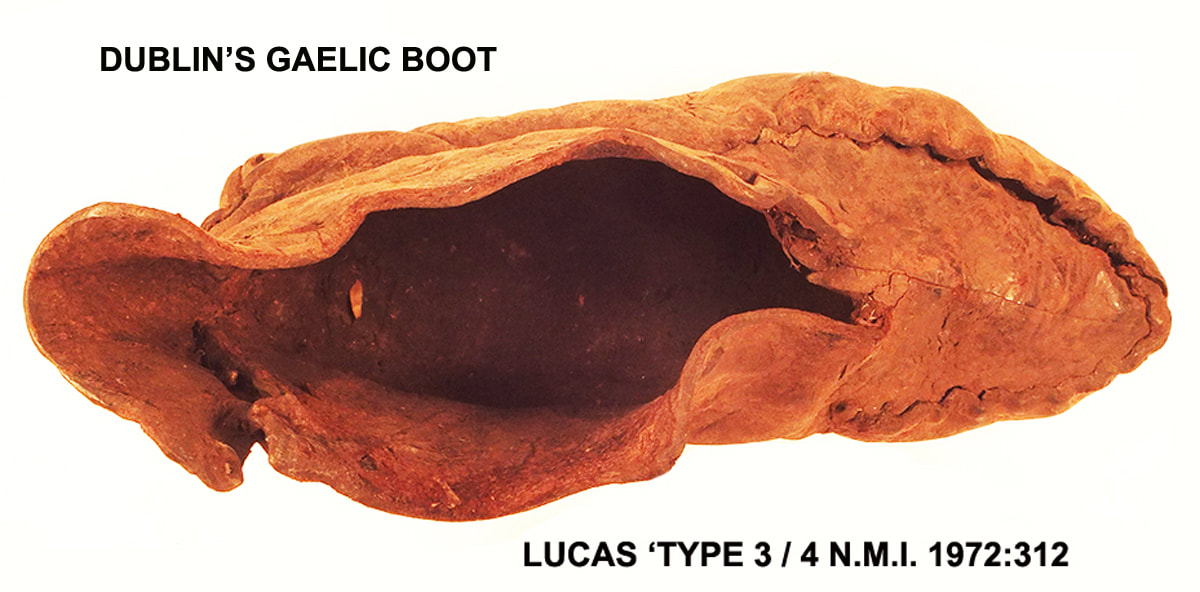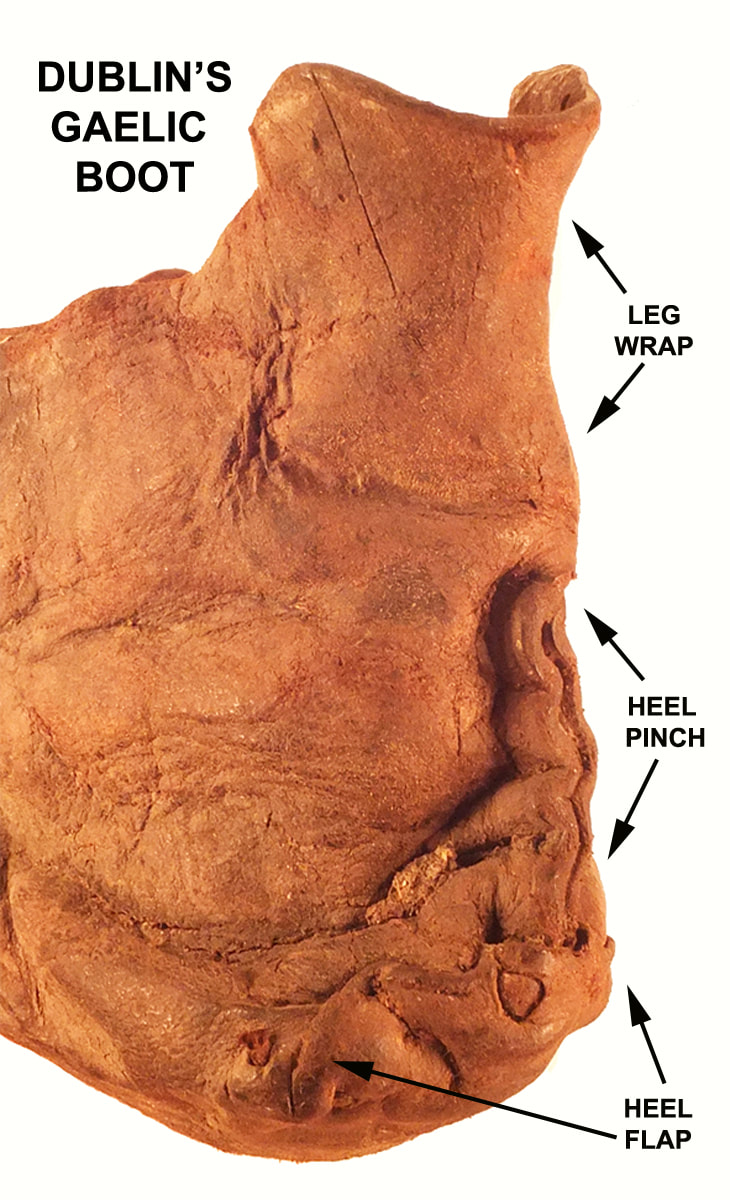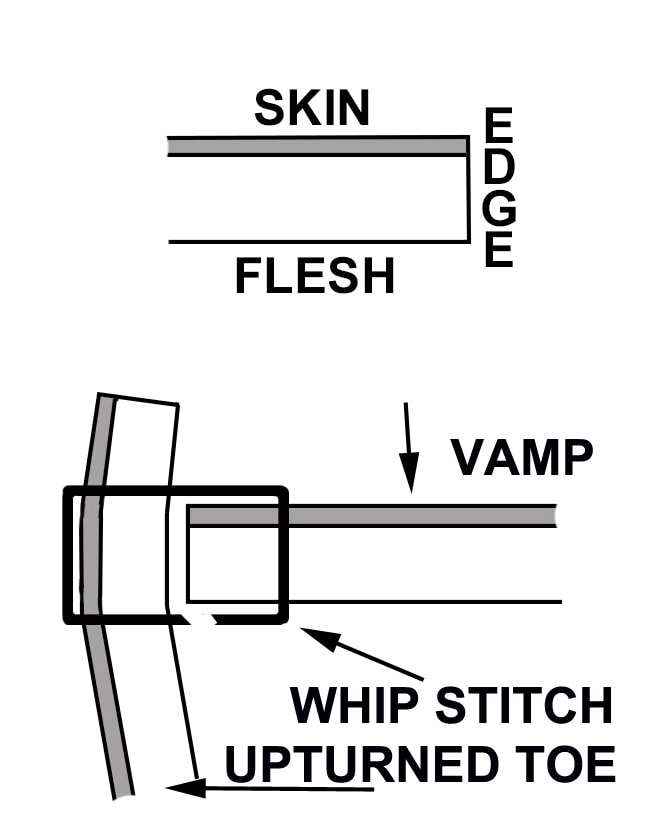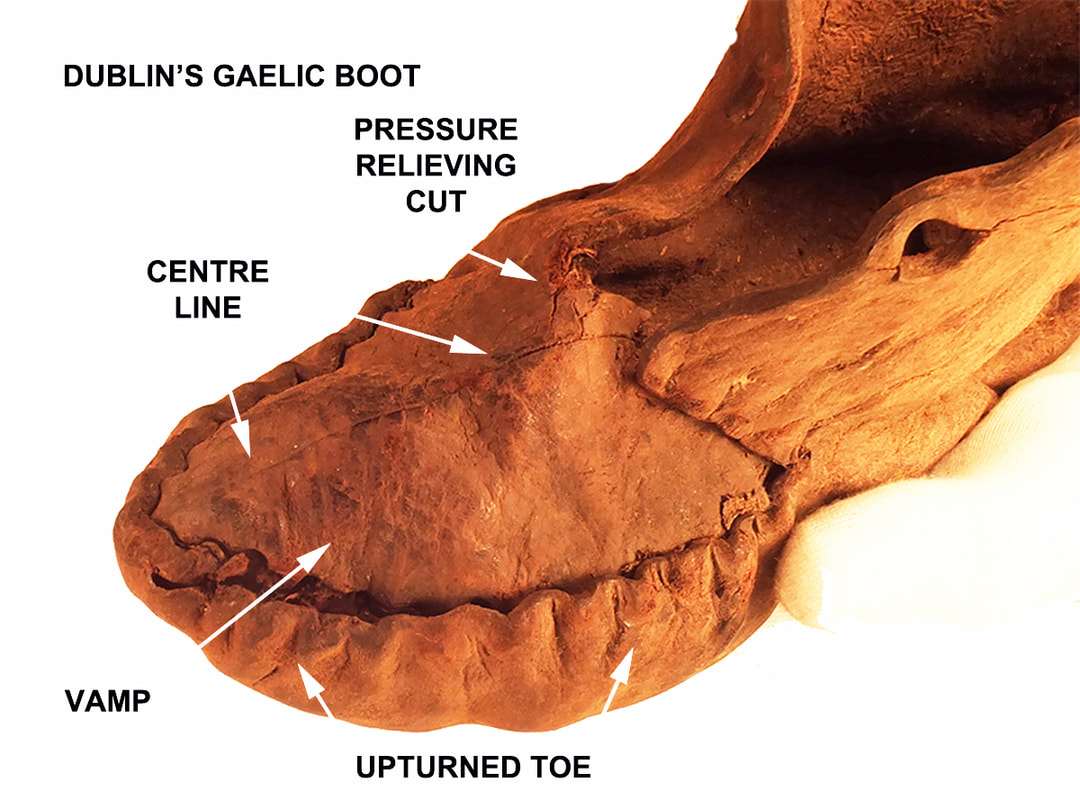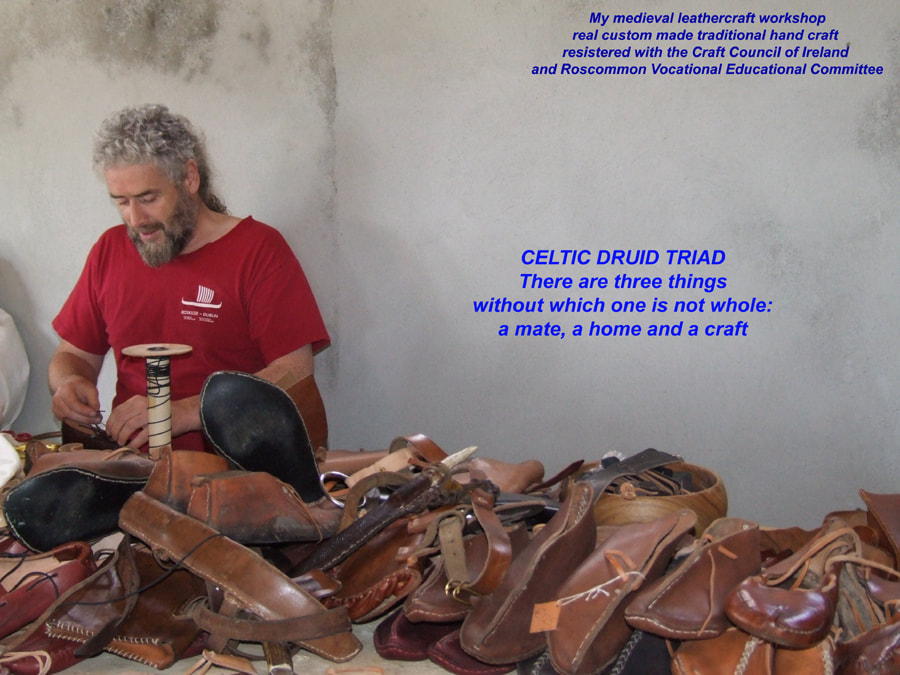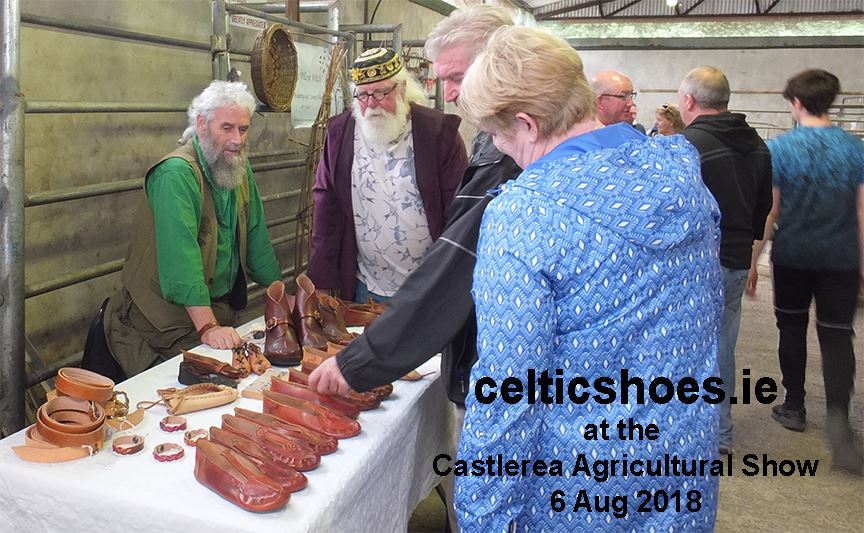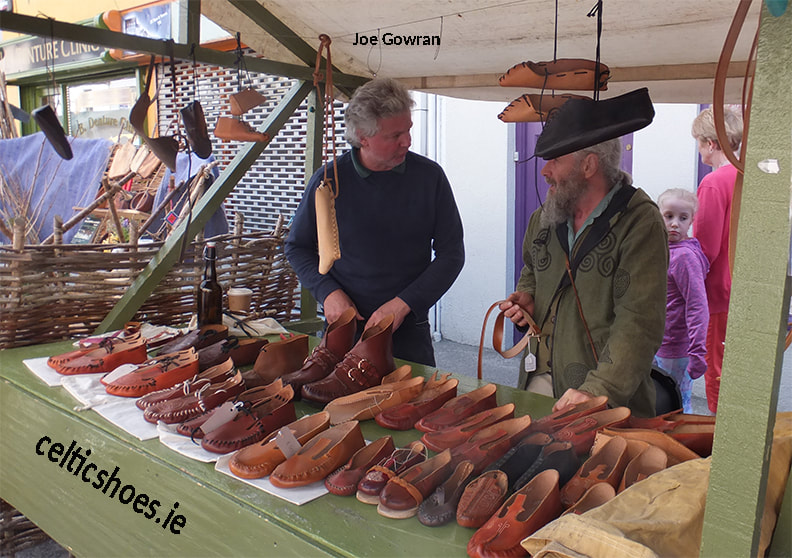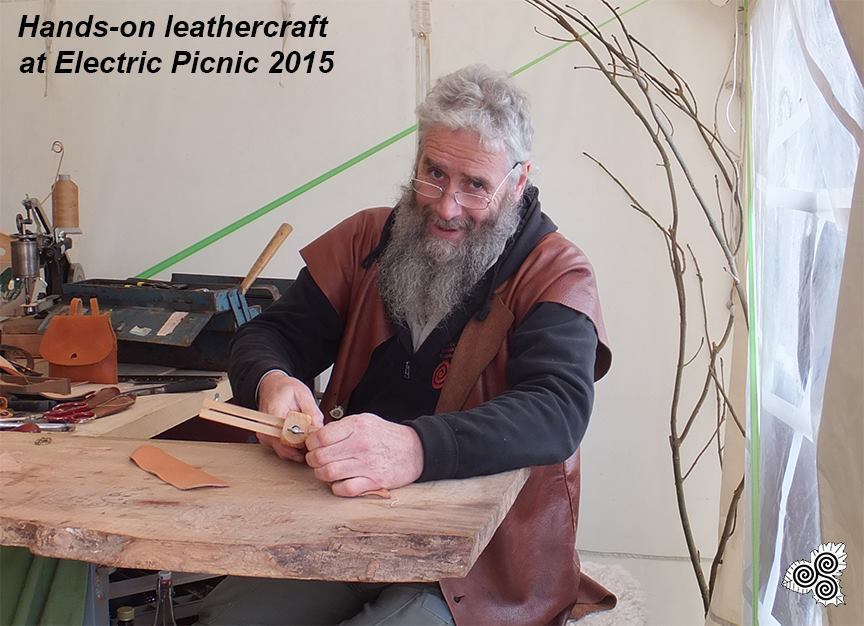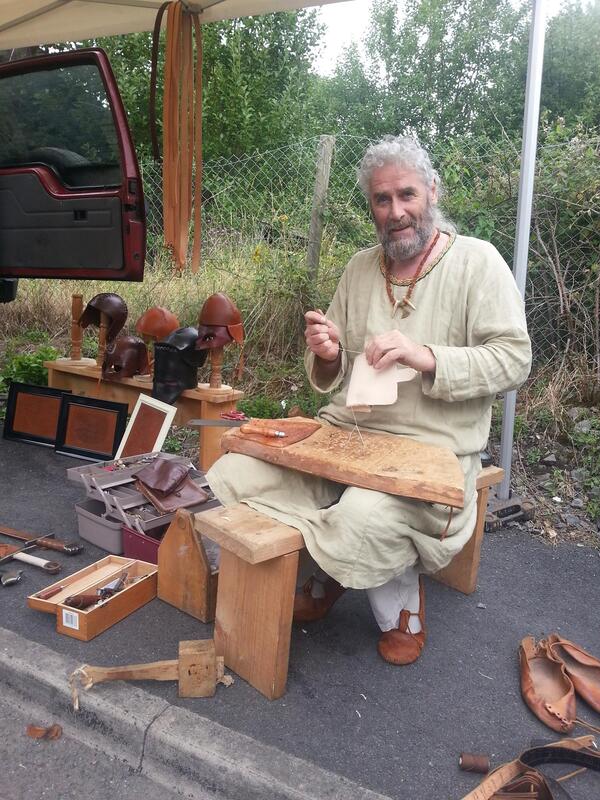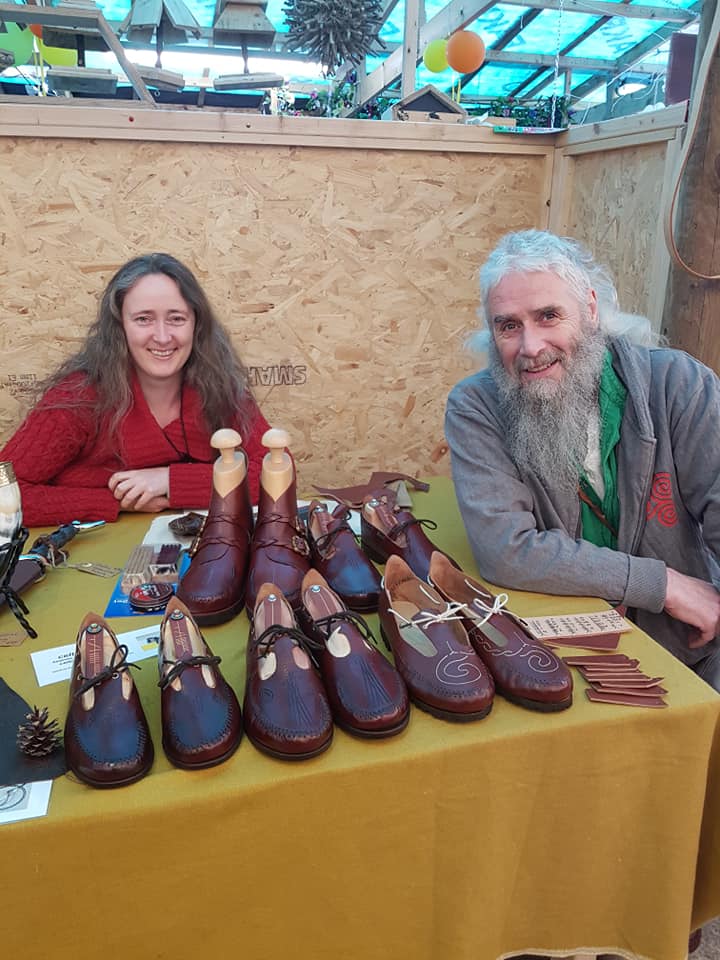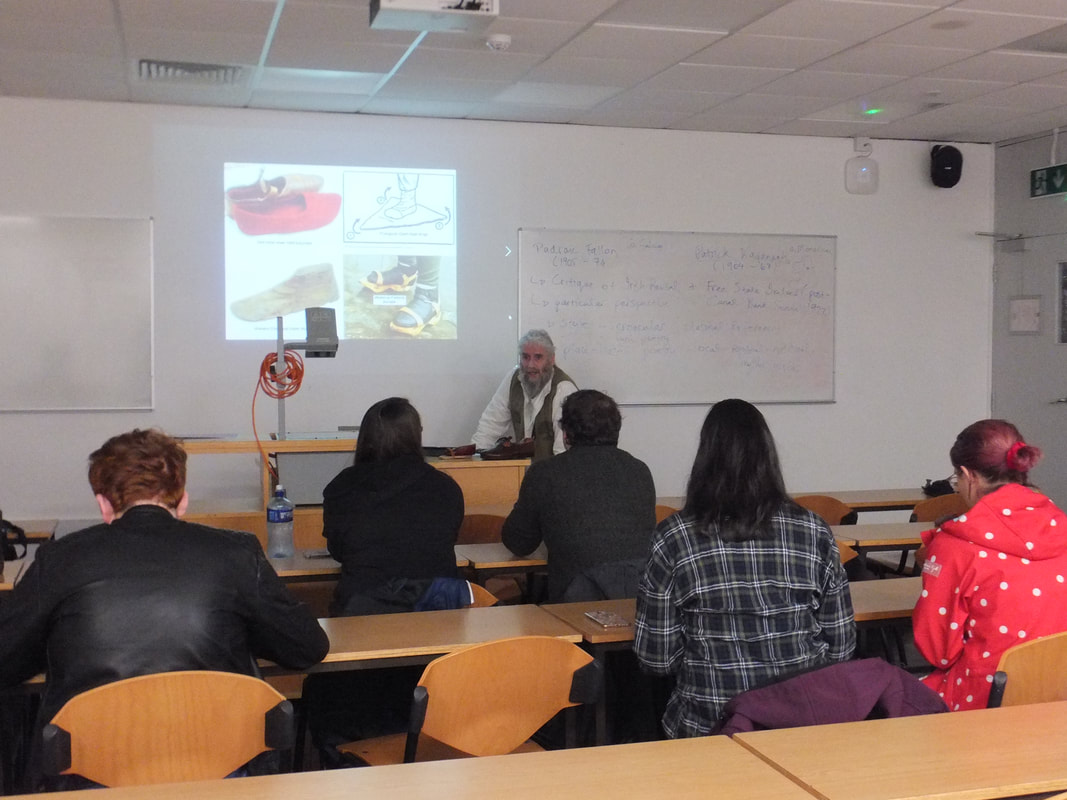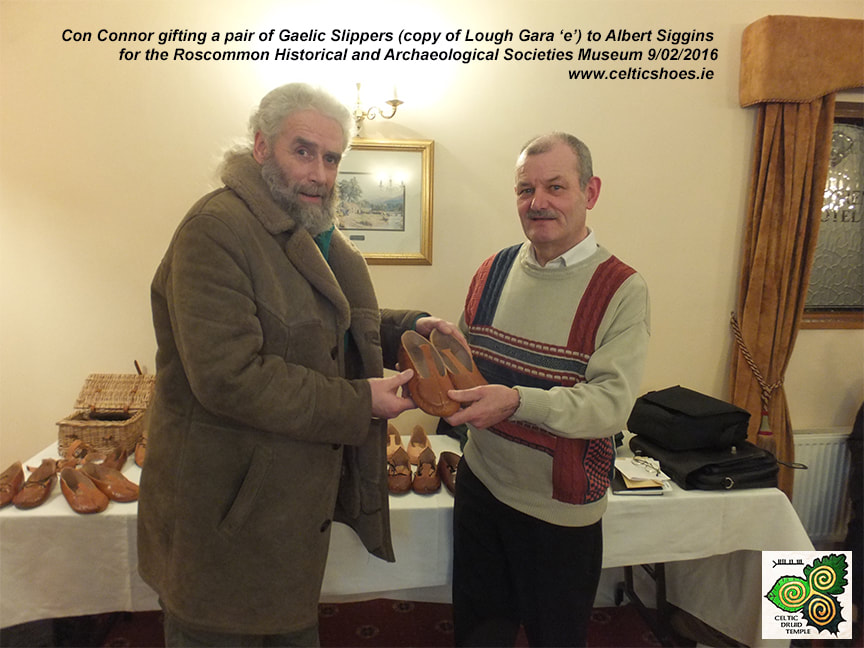About Celtic Shoes
I offer these hand made leather shoes as modern versions of the shoes our ancestors wore. These shoes are available as standard sizes and as a custom made bespoke version to precisely fit your feet.
Each pair of shoes are crafted from the same shoulder of leather and each shoe has the upper made in a single piece that is cleverly cut and folded as sewn into its design shape. These shoes are based on and include the geometry from a shoe found in the west of Ireland dating to the late bronze age, but updated for modern Celts to wear. Elegance displaying Celtic cultural pride! |
About Gaelic Boots
|
I offer these hand made leather boots as modern versions of the boots our ancestors wore. These boots are available as standard sizes and as a custom made bespoke version to precisely fit your feet.
Each pair of boots are crafted from the same shoulder of leather and each boot has the upper made in a single piece that is cleverly cut and folded as sewn into its design shape. These boots are based on and include the geometry from a boot found in Dublin dating to the Brian Boru era, but updated for modern Celts to wear. Elegance displaying Celtic cultural pride! |
Customer Testimonials
|
Meet the Maker - Passionate about Irish history
|
The 'Lough Gara' Gaelic Shoes and 'Brian Boru' Gaelic Boots are hand made by Con Connor, a Celtic Druid who lives with Niamh in the West of Ireland. I provide quality leather shoes and boots inspired by our culture and tradition. The Irish have often been depicted in the history books as barefoot savages. I've found evidence that this is not the case. Ireland's wealth was in it's cattle, and with a lot of cattle you have a lot of leather. I started to ask questions and travel to museums in search of the Irish shoe. As it turns out Ireland has a unique style of footwear that is is full of style and unnecessary embellishment.
|
Gaining exposure for these noble Irish Celtic Shoes is just one step in the re-emergence of our Celtic identity. With my shoes and boots you can now wear customized footwear as an expression of this cultural ancestral treasure. You can wear a unique piece of Irish History.
Celtic History and Heritage
|
In an ongoing recovery of our forgotten Celtic heritage and culture I have visited several museums that hold artifacts of our ancestor’s footwear. These include the National Museum of Ireland in Kildare St Dublin, Armagh and Belfast Museums and the London Museum of Archaeology. This ‘hands-on’ research informs the design and making of all my footwear. See my essay "In the footsteps of the noble Gael" on the Gaelic Slipper published in the book of essays for the Irish Chiefs' and Clans' Prize in History. The book is an anthology under the heading of - "Politics, Kingship and Culture in Gaelic Ireland c1100 - c1690. The editors even included a mention of my path as a Celtic Druid. Read the essay here.
|
Gaelic Slipper, Shoe and Boot - some lecture images with notes
This is the most recent version (Samhain 2019 for NUIG) of my presentation on this unique style of Irish footwear. I have made this lecture available here to inform as many people as possible that the "Irish did wear shoes". The core style concept can be traced from the late bronze age up to the Brian Boru era. Brief notes are given, please note - this is a one hour+ presentation usually followed by Q+A.
In the Louth shoe above we see the original hidden stitching and the surface 'repair' visible sewing that was done to try to keep this exquisite example of our ancestors footwear in one piece.
The multiple shoes image above is a composite of the best of or the most recognizable shoe artifacts in Ireland at this time. There is also a very beautiful example on display in Dublin - pics later. The research got myself and my wife Niamh into the crypt under the National Museum in Dublin for an entire day. We also got a day of full access to the shoe in the Armagh museum and in the Belfast Museum. Then we heard of the London Gaelic Shoes... we got a full day examining these in the Museum of London Archaeology - pics later in this lecture.
The first pair of Gaelic Slippers that I made are the Ballinderry type. The sword (a gift from my re-enactment group) is a replica of the famous sword on display in the NMI called the Ballinderry Sword and was found in the area where the shoe was found. It was forged from crucible steel making it the cleanest / strongest steel sword of its era - my sword sings when it makes contact with anything solid! The geometry on the vamp of the shoe in my version is central. Many, many years later in the crypt of the NMI I got to see, handle and photograph the actual artifact. It was listed as 'location outstanding' so I did not know I'd seen it! At home looking at the pictures Niamh took I recognised the symmetric geometry on the vamp. It was not central. The central 3 lines up the vamp to the tongue were incised - cut into the leather but the opposing triangles / dicky bow geometry had faded out of the leather because it was presumably impressed into the leather with a stylus. The line sketch was professionally done after the excavation and is a precise representation showing the offset dicky bow.
This slide shows the locations for the terminology I use in describing each artifact in this series. The beautiful shoe on the lower right is the one on display in NMI - above it is my replica. AT Lucas in his report mentions the Galway shoe only briefly for some as yet undefined reason. It has a separate leather addition for the heel and toe taking it from a slipper into a shoe. Close examination shows other 'extra sewing holes' suggesting that at one time this shoe probably had a one piece 'sole unit' to use modern shoe terminology. The full outsole version required the sewing of the outsole to the one piece upper before the sewing of the vamp to the toe, this requires very precise assembly of prefabricated components. Bear in mind that the vamp to the toe stitching is done inside the shoe as invisible stitching - when done - no thread is visible. When I make replicas of these slippers/shoes /I do not make them as a 'turnshoe'. Pics coming up in the next slide...
The miniature / child size shoe getting sewn above was done many years ago to create proving photographs for my assertion that these shoes could be sewn with an internal hidden whip stitch. Notes- less than 4" long but sewn with a 2" needle, vege tan 3mm leather and linen thread. This was one of my early lectures and was printed in the Roscommon Historical and Archaeological Society Journal Vol 13, pgs 19-22. Lectures were also given at Sligo IT and to the Ballintobar Castle excavations team of archaeologists and anthropologists under guidance from Irish medieval archaeologist, Dr Niall Brady A later version of this lecture is also published in the book - Politics, Kinship and Culture in Gaelic Ireland, C.1100-C.1690, Essays for the Irish Chiefs' and Clans' Prize in History (isbn in the essay here ) Priced at €35, available online, no revenue to essay contributors. My 'shoes' date from the late bronze age so I am very happy to be included in this prestigious book. My recent lecture to NUIG students forms the basis of this slide show.
The 4" miniature / child size shoe from the previous image is shown on the left in the above image. On the far right is the Dublin Boot from the Brian Boru era that I now make modern versions of. None of the artifacts - slippers, shoes or boot would fit a 6 foot tall man, say a size 10. Most were approx size 6 to 9.
Our ancestors wore their footwear differently to most Irish people today. Felt inner shoes must have been worn in Ireland - no artifacts - but common sense. Footwraps are the most simple protection for the feet and perhaps when we think of the cold wet season = the wool footwrap covered with the linen footwrap double insulating layers system must have been worn in Ireland - no artifacts - but common sense prevails again. A shoe last forms the shape of the newly sewn wet shoe (the shape is defined by the cut) and although I did not use a last for the miniature shoe they are needed for all the bigger sizes. Pattens are also a must if you are 'out and about' anywhere not just because the elevate you over the muck and wet but because they also protect the leather from abrasive contact with the damp grass and gravel.
A down view on four shoes, all have internally hidden stitching. LT1(e) has the longest tongue of all the shoes. The incised center line although straight is confusingly off center. LT1(b) shows exquisite geometry but has two short linear sections cut out of the vamp to expand the width for the hinge point of the foot, probably to accommodate a growth spurt in the size 5/6 user or an adaptation to fit a second user. LT1(f) has incised opposing 'P's around a center line and a half Celtic Knot - the 'P's are off center and the knot is broken open... The LT1 from Belfast is 100% complete. A pointy shoe with a vamp end that joins the heel wrap - visible around the heel is the possible wear from a leather strap from a patten.
Some modern versions of the LT1(f) that //I have made and sold. Available to order - order now. Showing size 8 top left, size 9 top right, size 10 lower left and the currently produced standard version in the lower right size 10 (mine...)
An image from the upcoming book... 9 and 10 are from London with 9 being original artifact and 10 is a modern replica. 13, 14 and 15 are my replicas. 16-20 are shoe images from various manuscripts. 17 is the only image showing lacing crossover. 16-20 could also be Maelassa or Lucas Type 2 but the long tongue and round cutouts each side of the tongue strongly suggest Type 1 - the Gaelic Slipper.
The two shoes in the top left were found in Craigywarren. The fragment in the very top left is maybe from a size 4 ladies today. The very top left fragment displays double spirals - culture expressed with pride. The top 1mm skin has separated from the 2mm fleshcrumb (delamination) but the vamp and tongue with opposing spirals survived the harsh conditions from the time it was lost. The Craigywarren shoe with the geometry and two cutouts to fit a bigger foot is shown side view - note incised curvilinear line. The other three images are of the Louth Shoe - It has rectangular slots for a leather thong lace. Interestingly these rectangular lace slots come right up to the vamp. It is a wide shoe for its length and maybe it is a size 8 that was worn with winter double wraps or high sided felt inner shoe. It has holes for a sole unit and is worn through at the heel and ball of the foot.
Our research visit to MOLA gave us an entire day with the entire shoe collection from a single excavation. This research expedition was financed by the Celtic Druid Temple, a religious charity in Ireland see https://www.celticdruidtemple.com/ The MOLA Book is available at www.mola.org.uk, title 'The development of early medieval and later Poultry and Cheapside: excavations at 1 Poultry and vicinity, City of London'. The religious Irish in London during the later Viking era wore a very distinctive version of the classic one piece Gaelic Slipper as shown here. One piece, tab up the vamp or heel, heel peak, sole turned up to meet the vamp, long tongue tradition with extra design refinements or unnecessary embellishments. They were all dumped in the septic tank of the church creating almost prefect re-tanning / preservation. Most had repairs and most were made for children, this may point to the role / function of that Irish church community within London. The red miniature shoe above with real silver ivy leaf is my 'show off' piece - this always impresses...
A recreation of the London Gaelic Slipper by Dr Markita Volken. Her book - Archaeological Footwear: Development of Shoe Patterns and Styles from Prehistory til the 1600's ISBN10 9089321179 and ISBN13 9789089321176 is a must for all researchers and modern leathercrafters. Markita also runs an ancient shoe museum - Musée de la Chaussure, Rue du Rôtillon 10, 1002 Lausanne, Switzerland.
I'm self trained as a Celtic Shoemaker. I have brought the bronze age style of the Lough Gara Shoe into the modern age so we can wear them in comfort with cultural style. A hard wearing studded rubber sole unit with a studded heel attaches to a mid sole of hardened 3mm vege tan leather onto the single piece upper. A soft leather insole gives a comfortable foot bed. Our ancestors walked leaning forward and we walk leaning back - I generalize here - I've brought the original design forward for use today.
Found in the 70's during the Wood Quay excavations and labeled a Type 3 (a multi-part high shoe / boot) probably because the finder had no awareness of the defining characteristics of the Gaelic Slipper and Shoe. One piece, tab up the heel, wrap around heel with peak, sole turned up to meet the vamp with the extra design refinement / unnecessary embellishment of a center line on the vamp. Maybe a size 7 or 8. No stitch holes underneath but some indication of a pattern strap is visible. My modern versions got a midsole and an studded rubber outsole with heel, a soft veg tan insole and two Celtic Knot straps with ornate brass buckles. Current version being tested is a lace up dress boot. Currently not available for sale at Samhain 2019 but I'm very pleased with the test use so far... If you want to know when its available please get on our mail list below.
Me posing in the 'lab' in the crypt of the National Museum of Ireland in Dublin. Note the white gloves. Not only could I see and touch all the slippers and shoes but I could also see and hold a boot from the 'Brian Boru' era. Pics by Niamh.
Four museum grade replicas all approx size 6. These are brought to all lectures giving attendees a chance to see, touch and smell a reproduction of the footwear of our ancestors.
A part of the inauguration rite for a Gaelic king was throwing a shoe over his head. Many gifts were given and a ritual observed, a new pair of shoes was one of the gifts and perhaps the throwing away of an old shoe meant leaving the past behind as a new path as king is to be walked. This is the O'Neale clan tradition see http://ancientclanoneill.com/tullaghoge-project
I made and fitted a pair of shoes to a mannequin on the 26th of June 2019. High status shoes for the noble Gael to replace his low status pompooties that were out of character with his status as declared by his gold jewellery, leine and trews with sword and shield! Based on the shoes found in excavations of a crannóg in Lough Gara on the Sligo / Roscommon border = he is now properly dressed as a noble Gael. I handmake each of these shoes in a single piece of leather. This single piece leather slipper with a leather midsole and studded rubber sole unit with heel is the Gaelic Shoe currently being made - if you are interested please use the inquiry form below.
Update 05/08/2022
Very pleased to install this commission for our local heritage centre https://www.facebook.com/Rathcroghan of upgrading the leather kit of a high status warrior. Not a wealth display or over done but a simple lightweight kit for a fast moving swordsman. His shield is a replicia of the Clonoura shield that shows wear marks from punching an incoming sword or spear away from the body, his belt is extra long to allow the long hanging down end with of course a brass D pin buckle, his sword arm has a light weight leather bracer, his scabbard is 3 layers of leather, his leather belt bag contains 3 secret things and his shoes are based on the find by a crannóg in the local lake Lough Gara. All handmade by me using quality Italian leather, fitted by me with pics by Niamh. Dathaí Abú
Very pleased to install this commission for our local heritage centre https://www.facebook.com/Rathcroghan of upgrading the leather kit of a high status warrior. Not a wealth display or over done but a simple lightweight kit for a fast moving swordsman. His shield is a replicia of the Clonoura shield that shows wear marks from punching an incoming sword or spear away from the body, his belt is extra long to allow the long hanging down end with of course a brass D pin buckle, his sword arm has a light weight leather bracer, his scabbard is 3 layers of leather, his leather belt bag contains 3 secret things and his shoes are based on the find by a crannóg in the local lake Lough Gara. All handmade by me using quality Italian leather, fitted by me with pics by Niamh. Dathaí Abú
My research undoes the often repeated fake history of the 'Irish did not wear shoes'... Of course we did - the country was producing vast quantities of tanned leather as a product made from raw hide. Even today there are 2.5million cows processed every year and over 800 thousand cows shipped live from Ireland. There is no tannery in Ireland and I must buy my leather from offshore - I choose the best quality leather from Italy to craft my modern Gaelic Slipper, Shoe and Boot.
The above notes share some of the story and in my book 'Gaelic Slipper, Shoe and Boot' I include a Gazetteer for all currently known artifacts. A work in progress...
The above notes share some of the story and in my book 'Gaelic Slipper, Shoe and Boot' I include a Gazetteer for all currently known artifacts. A work in progress...
The Gazetteer entry for the Gaelic Boot
When I started to study the ancient Irish footwear styles all I could find online was just a few secondary research articles based on the Lucas report written by history enthusiasts. Then I got access to Margrethe Hald’s ‘Primitive Shoes’ book which focuses primarily on shoe finds from the Jutland Peninsula. She included 12 pages on Irish Footwear and uses AT Lucas sketches but only briefly refers to the Gaelic Slipper I was researching. The next book I encountered was ‘Stepping through time’ by Olaf Goubitz, Carol van Driel-Murray and Willy Groenman. This book is important for European Footwear and craft methods but not for the shoes I was interested in. Visits to the National Museum of Ireland to look through glass at the Leitrim Slipper on display lead me to thinking that there must be more examples and that some professional archaeologist/s must have produced a paper on this unique Irish style - but there is no such paper available. Later on when I had studied archaeology at NUIG, I with my wife Niamh got direct access to all known examples of the Gaelic Slipper in the National Museum of Ireland. Book research identified an Irish Archaeologist – Mairead Dunlevy, whose excellent 1989 book “Dress in Ireland” showed a small photo of the Louth Slipper. This Louth Slipper is the one most referenced online as well. In a report by the Rev James Graves “The Journal of the Kilkenny and South-East of Ireland Archaeological Society” based on Wilde's catalogue on page 269 there is a sketch of a Leitrim Slipper, the actual slipper that was currently on display in the National Museum of Ireland (2017). Wilde, W. R. described some of these slippers in the “Catalogue of the Antiquities of the Royal Irish Academy.” Dublin 1857 pp 280-292. When A. T. Lucas presented his paper on Footwear in Ireland in the County Louth Archaeological Journal Vol. XIII 1953-56 he wrote – “Since no study of this material has appeared since Wilde described those examples available to him a century ago, it seems timely and desirable to give a short account of them, especially since a large number have come to light since his time” (Lucas 1956 pp366). In 1857; Wilde W. R. described the known Gaelic Slippers and in 1956; Lucas A. T. gave an update on finds since Wilde in his paper and now in 2022 I’m presenting a leather crafter's perspective on the Gaelic Boot that also considers this particular style of footwear as a part of cultural identity in a distinct regional group on the western isles of medieval Europe. My thanks go to a senior member of the National Museum of Ireland staff who posted a full photocopy of the AT Lucas paper to me - this really helped my research and development work. Before I started to craft shoes, slippers and boots I had to learn about leather both in its modern and historical context. My early experiments with handcrafting leather shoes are detailed in my article ‘In the footsteps of the noble Gael’ contained within the 2018 publication ‘Eassys for the Irish Chiefs’ and Clans’ Prize in History’.
Leather was and still is a renewable and sustainable raw material. Ireland’s wealth was always in cattle and it must be assumed that this island exported a vast quantity of tanned and untanned hides in historic and in ancient times to seaports along the coastline of Europe. Today in Ireland, over 2.5 million cattle are slaughtered and 800k+ are exported live annually, this equals approx. 3.3 million hides – this is continuation of an indigenous industry that has its roots in the green grass of Ireland. Today however there are no tanneries in Ireland and Irish leather craft workers have to import from England or mainland Europe. P.W. Joyce in his 1906 publication titled a ‘Smaller Social History of Ancient Ireland’ gives us some of the basic details: “the art of tanning leather was well understood in ancient Ireland. The name for a tanner was súdaire [soodera], which is still a living word. Oak bark was employed, and in connexion with this use was called coirtech [curtagh: Lat. cortex], as we find the word used in the Laws. By the process of tanning, the hide was thickened and hardened, as at present. Tanned leather was used for various purposes, one of the principal being as material for shoes”.
Neither leather nor the tanning substances are found in a usable natural state, they must be processed and combined by man. Roy Thompson explores in his 1982 paper ‘Tanning, Man’s first Manufacturing Process?’ the concept of leather being one of the first man made products. In their 1991 article ‘Leather: Its Composition and Changes with Time’ Calnan and Haines tell us that the complex organic tissue we know as skin was traditionally converted into leather by removal of its non-fibrous proteins and the addition of vegetable tannins.
Hide to leather was a native leather tanning industry in its own right. Value added leather processed into footwear and exported by seafaring traders all over Europe had to rely on an existing stable Irish society to produce the leather first. In Carol van Driel-Murray’s 2011 report ‘Leather and Footwear’ contained within the Rothwell Leeds West Yorkshire Excavation report 2170:47-54 we are told that the “manufacture of footwear relies on the production of leather, which in turn involves domestic animal populations, the processes and by products of the food chain, plus all aspects of tanning: from the complex use of chemistry necessary for transforming a raw skin into a stable material to the spatial and economic organisation of tanneries.” Esther Cameron in her 2000 report titled ‘Sheaths and Scabbards in England AD 400-1100’ states that the “tanning of hides involves soaking in oak-bark liquors for one to three years and requires substantial economic investment as well as a regular supply of raw materials, it is a technology suited to stable, urbanised societies”. Tanning leather for clothing and footwear requires a dry set up and to be well away from damp conditions such as beside rivers but at the same time the process requires lots of water. Later on in the Norman era the business model changed with the advent of extensive tanning pits in Dublin. Antoine Giacometti in his article ‘Blackpitts: Dublin’s medieval tanning quarter’ tells us that the first definitive medieval tanning pit in Dublin was identified in 1990 (pit 11, site B in Walsh 1997, 39) and it was a fourteenth-century oak-stave and stone-lined tanning pit on Patrick Street.
Esther Cameron in her 2007 book ‘All about Scabbards and Sheaths from Viking and Medieval Dublin’ tells us that from the archaeological excavations between 1962 and 1981 of old Dublin (Viking Era) there was over 5500 leather finds and that the greatest group type was 16% for footwear, this means that 880 finds were shoes or parts of shoes – see photograph Pl.1. High Street 1967-72; excavations of the thick layer of ‘leatherworking scrap’ on pg 5 of her 2007 book. While these were Viking styles and not ‘Irish’ shoes - one of the finds during the excavations was a unique Gaelic Boot!
Dublin’s Gaelic Boot
Official Record - National Museum of Ireland Lucas Type 3-4, 1972:312 B23 14/15 Leather Shoe Fishamble Street, Wood Quay, Dublin. (Note – Listed as Lucas Type 3/4 but it is a Type 1)
Leather was and still is a renewable and sustainable raw material. Ireland’s wealth was always in cattle and it must be assumed that this island exported a vast quantity of tanned and untanned hides in historic and in ancient times to seaports along the coastline of Europe. Today in Ireland, over 2.5 million cattle are slaughtered and 800k+ are exported live annually, this equals approx. 3.3 million hides – this is continuation of an indigenous industry that has its roots in the green grass of Ireland. Today however there are no tanneries in Ireland and Irish leather craft workers have to import from England or mainland Europe. P.W. Joyce in his 1906 publication titled a ‘Smaller Social History of Ancient Ireland’ gives us some of the basic details: “the art of tanning leather was well understood in ancient Ireland. The name for a tanner was súdaire [soodera], which is still a living word. Oak bark was employed, and in connexion with this use was called coirtech [curtagh: Lat. cortex], as we find the word used in the Laws. By the process of tanning, the hide was thickened and hardened, as at present. Tanned leather was used for various purposes, one of the principal being as material for shoes”.
Neither leather nor the tanning substances are found in a usable natural state, they must be processed and combined by man. Roy Thompson explores in his 1982 paper ‘Tanning, Man’s first Manufacturing Process?’ the concept of leather being one of the first man made products. In their 1991 article ‘Leather: Its Composition and Changes with Time’ Calnan and Haines tell us that the complex organic tissue we know as skin was traditionally converted into leather by removal of its non-fibrous proteins and the addition of vegetable tannins.
Hide to leather was a native leather tanning industry in its own right. Value added leather processed into footwear and exported by seafaring traders all over Europe had to rely on an existing stable Irish society to produce the leather first. In Carol van Driel-Murray’s 2011 report ‘Leather and Footwear’ contained within the Rothwell Leeds West Yorkshire Excavation report 2170:47-54 we are told that the “manufacture of footwear relies on the production of leather, which in turn involves domestic animal populations, the processes and by products of the food chain, plus all aspects of tanning: from the complex use of chemistry necessary for transforming a raw skin into a stable material to the spatial and economic organisation of tanneries.” Esther Cameron in her 2000 report titled ‘Sheaths and Scabbards in England AD 400-1100’ states that the “tanning of hides involves soaking in oak-bark liquors for one to three years and requires substantial economic investment as well as a regular supply of raw materials, it is a technology suited to stable, urbanised societies”. Tanning leather for clothing and footwear requires a dry set up and to be well away from damp conditions such as beside rivers but at the same time the process requires lots of water. Later on in the Norman era the business model changed with the advent of extensive tanning pits in Dublin. Antoine Giacometti in his article ‘Blackpitts: Dublin’s medieval tanning quarter’ tells us that the first definitive medieval tanning pit in Dublin was identified in 1990 (pit 11, site B in Walsh 1997, 39) and it was a fourteenth-century oak-stave and stone-lined tanning pit on Patrick Street.
Esther Cameron in her 2007 book ‘All about Scabbards and Sheaths from Viking and Medieval Dublin’ tells us that from the archaeological excavations between 1962 and 1981 of old Dublin (Viking Era) there was over 5500 leather finds and that the greatest group type was 16% for footwear, this means that 880 finds were shoes or parts of shoes – see photograph Pl.1. High Street 1967-72; excavations of the thick layer of ‘leatherworking scrap’ on pg 5 of her 2007 book. While these were Viking styles and not ‘Irish’ shoes - one of the finds during the excavations was a unique Gaelic Boot!
Dublin’s Gaelic Boot
Official Record - National Museum of Ireland Lucas Type 3-4, 1972:312 B23 14/15 Leather Shoe Fishamble Street, Wood Quay, Dublin. (Note – Listed as Lucas Type 3/4 but it is a Type 1)
Description
A virtually unknown Gaelic style of Boot was found during excavations in Dublin in 1972. Apart from the securing lace that is missing - this Boot is 100% extant. It can be called a low boot or a high shoe but the absence of any evidence of an attached outsole strongly suggests that it was worn with a patten ie a wooden sole or clog. This boot was made from a single piece of approx. 3mm veg-tanned leather, probably bovine in origin. There are no wear holes or patches on the sole or on the heel. The high sides at the heel cover the ankle bone enough to allow secure fixing above the ankle. It has a long or extended toe. The sewing at the vamp is of a style not seen in any of the Gaelic Slippers with the exception of the Armagh Gaelic Slipper ARMCM.347. This Brian Ború era boot has a fold over vamp with an engraved centre line but it was made without a fold up tab from the sole on to the vamp as seen on most Gaelic Slippers but not on the Armagh Gaelic Slipper ARMCM.347. The heel including the ankle support and the back of the leg is unique in its engineering and sewing while displaying some similarities to the known Gaelic Slippers.
Sewing
My visual inspection with the naked eye and with a magnifying glass followed up by computer enlargements suggest that the vamp and the heel of this boot were sewn with fibrous thread. One stitching style ‘the whip stitch’ with fibrous thread was used for the vamp - vamp side edge to inside flesh of the turned up toe, with partly visible thread.
A virtually unknown Gaelic style of Boot was found during excavations in Dublin in 1972. Apart from the securing lace that is missing - this Boot is 100% extant. It can be called a low boot or a high shoe but the absence of any evidence of an attached outsole strongly suggests that it was worn with a patten ie a wooden sole or clog. This boot was made from a single piece of approx. 3mm veg-tanned leather, probably bovine in origin. There are no wear holes or patches on the sole or on the heel. The high sides at the heel cover the ankle bone enough to allow secure fixing above the ankle. It has a long or extended toe. The sewing at the vamp is of a style not seen in any of the Gaelic Slippers with the exception of the Armagh Gaelic Slipper ARMCM.347. This Brian Ború era boot has a fold over vamp with an engraved centre line but it was made without a fold up tab from the sole on to the vamp as seen on most Gaelic Slippers but not on the Armagh Gaelic Slipper ARMCM.347. The heel including the ankle support and the back of the leg is unique in its engineering and sewing while displaying some similarities to the known Gaelic Slippers.
Sewing
My visual inspection with the naked eye and with a magnifying glass followed up by computer enlargements suggest that the vamp and the heel of this boot were sewn with fibrous thread. One stitching style ‘the whip stitch’ with fibrous thread was used for the vamp - vamp side edge to inside flesh of the turned up toe, with partly visible thread.
The 'fold up triangle' of the lower heel is sewn with leather thong. The approx. 2mm / 3mm thick leather thong at the heel triangle is approx 2-3 inches or 50-75mm long. The vertical heel seam is central and the lowest section (behind the fold up triangle) is sewn edge to edge, the middle section is sewn flesh to flesh creating a pinch or curve that helps to fit the curve of the human ankle.
The top section of the heel turns off to the side (as is standard in most Gaelic Slippers) where it returns to edge to edge sewing. This unique sewing style crafts a boot that keeps most of the stitching away from chafing contact with the skin of the owner’s heel. In my research I have not found any other boot to compare the complicated but functional heel stitching to.
Engraving
There is a single centre line engraved into the leather of the vamp. The centre line is unnecessary but perhaps showing a link to indigenous footwear styles of the Gaels that have centre lines carved and tabs from the sole sown on top of the vamp. Beside this centre line is what appears to be a cut to widen the boot at the tightest point. It is badly done, off centre and may indicate a pressure relieving cut by the owner or second owner.
Fastening
There are three lacing circular holes of approx 4mm for secure fastening above the ankle. No fastening thong or lace was attached. There is no visible (naked eye) strap wear on the vamp tongue area or behind the heel. Various attempts on replica boots I’ve made to use three lacing holes to secure the boot have not given comfortable success.
Condition
The Dublin Slipper Boot is a 100% (excluding the lace) unique artefact. It is the only one of its kind found so far. It would certainly benefit from modern restoration / preservation work.
Author
Con Connor lives near Castlerea in Co Roscommon and is a leather craft worker and teacher registered with the Craft Council of Ireland https://directory.dccoi.ie/clients/member/irish-celtic-shoes He has researched the Gaelic Slipper in the National Museum of Ireland, the Armagh and Belfast Museums and in the Museum of London Archaeology. He has displayed his craft-work in the National Museum and at Interpretative Centres and festivals throughout Ireland and has replicas of the Lough Gara shoe in the Roscommon County Museum, Rathcroghan Visitor Center and in the museum at Clonalis House, Castlerea, ancestral home of O’Conor clan. He has studied Archaeology at NUIG. Con is also a Celtic Druid with an online presence at www.celticdruidtemple.com Con has essays on Gaelic Shoes published with the Co Roscommon Historical and Archaeological Society Vol. 13 and in the 2018 “Essays for the Irish Chiefs’ and Clan’ Prize in History” Politics, Kinship and Culture in Gaelic Ireland c.1100-c.1690 titled “In the footsteps of the noble Gael”. Con has lectured on the Gaelic Slippers at the Archaeology Dept of Sligo IT 'Stones and Bones' society, the Cumann Seandálaíochta (Archaeology Society) National University of Ireland Galway, the Rathcroghan Visitors Center in Co Roscommon and to The Foothill Ireland Program, Castles in Communities excavations group in Ballintobar Co Roscommon.
Engraving
There is a single centre line engraved into the leather of the vamp. The centre line is unnecessary but perhaps showing a link to indigenous footwear styles of the Gaels that have centre lines carved and tabs from the sole sown on top of the vamp. Beside this centre line is what appears to be a cut to widen the boot at the tightest point. It is badly done, off centre and may indicate a pressure relieving cut by the owner or second owner.
Fastening
There are three lacing circular holes of approx 4mm for secure fastening above the ankle. No fastening thong or lace was attached. There is no visible (naked eye) strap wear on the vamp tongue area or behind the heel. Various attempts on replica boots I’ve made to use three lacing holes to secure the boot have not given comfortable success.
Condition
The Dublin Slipper Boot is a 100% (excluding the lace) unique artefact. It is the only one of its kind found so far. It would certainly benefit from modern restoration / preservation work.
Author
Con Connor lives near Castlerea in Co Roscommon and is a leather craft worker and teacher registered with the Craft Council of Ireland https://directory.dccoi.ie/clients/member/irish-celtic-shoes He has researched the Gaelic Slipper in the National Museum of Ireland, the Armagh and Belfast Museums and in the Museum of London Archaeology. He has displayed his craft-work in the National Museum and at Interpretative Centres and festivals throughout Ireland and has replicas of the Lough Gara shoe in the Roscommon County Museum, Rathcroghan Visitor Center and in the museum at Clonalis House, Castlerea, ancestral home of O’Conor clan. He has studied Archaeology at NUIG. Con is also a Celtic Druid with an online presence at www.celticdruidtemple.com Con has essays on Gaelic Shoes published with the Co Roscommon Historical and Archaeological Society Vol. 13 and in the 2018 “Essays for the Irish Chiefs’ and Clan’ Prize in History” Politics, Kinship and Culture in Gaelic Ireland c.1100-c.1690 titled “In the footsteps of the noble Gael”. Con has lectured on the Gaelic Slippers at the Archaeology Dept of Sligo IT 'Stones and Bones' society, the Cumann Seandálaíochta (Archaeology Society) National University of Ireland Galway, the Rathcroghan Visitors Center in Co Roscommon and to The Foothill Ireland Program, Castles in Communities excavations group in Ballintobar Co Roscommon.
